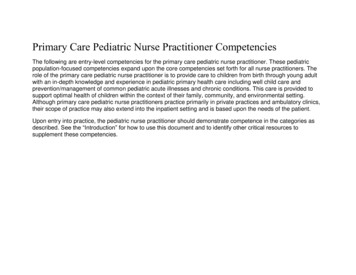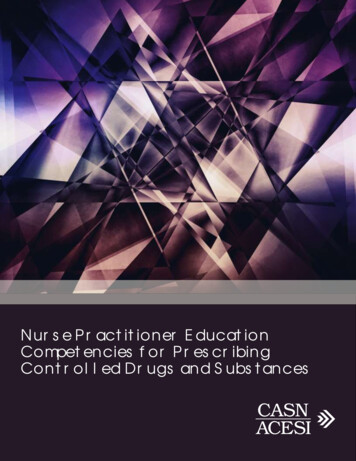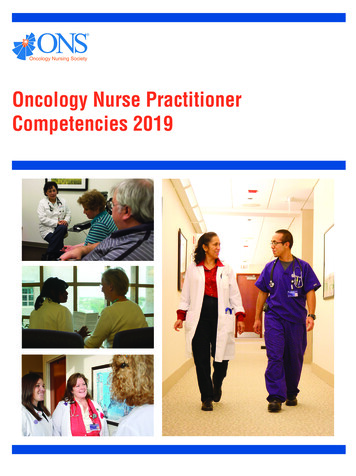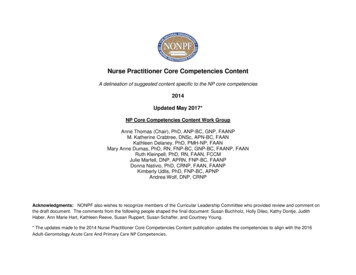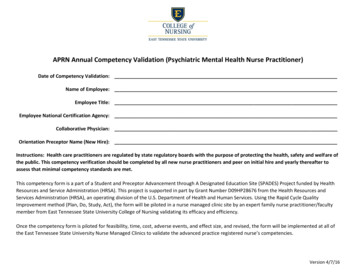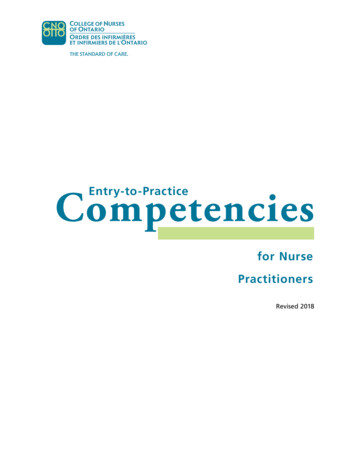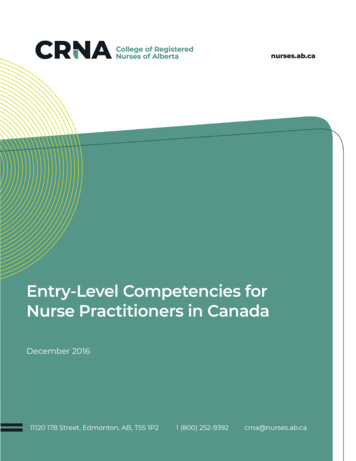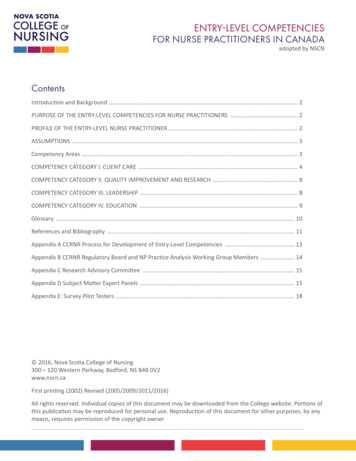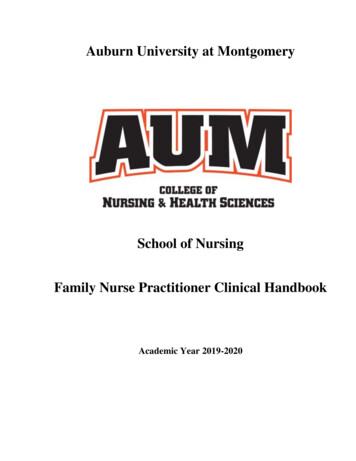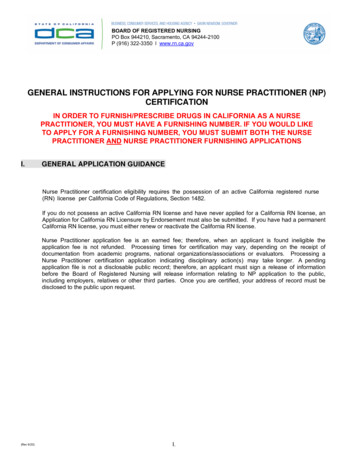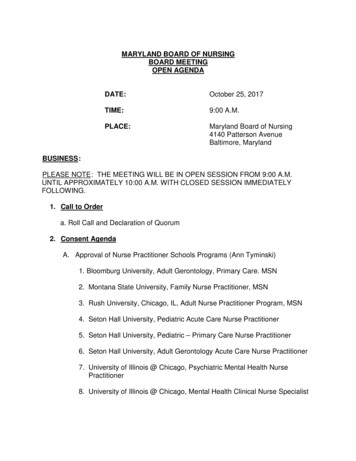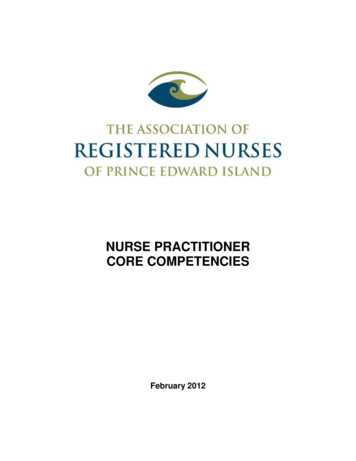
Transcription
NURSE PRACTITIONERCORE COMPETENCIESFebruary 2012
AcknowledgmentsThis ARNPEI document is adapted from the Canadian Nurse Practitioner Core CompetencyFramework (2010), which defines the core competencies required for safe, competent andethical nurse practitioner practice. Appreciation and thanks are extended to the regulatoryauthorities, the Canadian Nurse Practitioner Core Competency Committee, the RegisteredNurses Association of Ontario, and nurse practitioners across Canada who participated in thedevelopment of this document.The Executive Directors of the registered nursing regulatory bodies in Canada requested theCanadian Nurses Association and Canada’s Testing Company, Assessment Strategies Inc., tofacilitate the update and revision of the core entry-level competencies for nurse practitionerpractice in Canada. Through a series of teleconferences, electronic communications, subgroupwork and one face-to-face meeting, the Canadian Nurse Practitioner Core CompetencyFramework (2010) was completed. The Canadian Nurse Practitioner Core CompetencyFramework (2010) was developed for use by participating jurisdictions.This framework defines the core competencies required for safe, competent and ethical nursepractitioner practice. The core competencies are transferable across diverse practice settingsand client populations. As a result, the framework is fundamental to all nurse practitionerpractice in Canada.Association of Registered Nurses of Prince Edward Island53 Grafton StreetCharlottetown PE C1A 1K8Tel: 902-368-3764Email: info@arnpei.ca
Table of ContentsPageIntroductionProfile of the Nurse PractitionerOverview of onal Role, Responsibility, and AccountabilityA. Clinical PracticeB. Collaboration, Consultation and ReferralC. ResearchD. Leadership44556II.Health Assessment and Diagnosis7III.Therapeutic Management8IV.Health Promotion and Prevention of Illness and Injury10Glossary of Terms11References14
IntroductionThe competency statements describe the integrated knowledge, skills, judgments and attributesthat guide nurse practitioner practice. Safe, competent, ethical nurse practitioner practicerequires the integration and performance of many competencies simultaneously. Thisdocument may be used by nurse practitioners to support self-reflection, self-evaluation andcontinuing competence, as well as to educate others about their role. Nurse practitionereducators may use it for curriculum development. This document is also a useful resource forhelping others - including government agencies, employers, health providers and the public tounderstand what to expect of nurse practitioners.Profile of the Nurse PractitionerNurse practitioners, as autonomous health professionals with advanced education, provideessential health services grounded in professional, ethical and legal standards. They integratetheir in-depth knowledge of advanced nursing practice and theory, health management, healthpromotion and disease/injury prevention, and other relevant biomedical and psychosocialtheories to provide comprehensive health services. Nurse practitioners work in collaborationwith their clients and other health care providers in the provision of high quality patient-centeredcare. They work with diverse client populations, in a variety of contexts and practice settings.Nurse practitioners have the competence to provide comprehensive health assessment, todiagnose health/illness conditions and to treat and manage acute and chronic illness within aholistic model of care. Nurse practitioners order and interpret screening and diagnostic tests,perform procedures and prescribe medications, while integrating the principles of resourceallocation and cost-effectiveness, in accordance with federal and provincial legislation andpolicy.Nurse practitioners are accountable for their practice and to communicate with clients abouthealth assessment findings and diagnoses, further required testing, referral to other health careprofessionals and are responsible for client follow-up. Nurse practitioners counsel clients onsymptom management, health maintenance, pharmacotherapy, alternative therapies,rehabilitation strategies and other health programs.Nurse practitioners have the knowledge to assess population health trends and patterns anddesign services to promote healthy living. They provide leadership in the development,implementation and evaluation of strategies to promote health and prevent illness and injurywith interprofessional teams, other health care providers and sectors as well as communitymembers. Nurse practitioners collaborate in the development of policy to influence healthservices and healthy public policy.Overview of CompetenciesNurse practitioner competencies reflect advanced nursing practice by building and expandingupon the competencies required of a registered nurse. This document expands on thecompetencies defined in the Advanced Nursing Practice: A National Framework (CNA, 2008) as1
these competencies apply to nurse practitioners. The core competencies in this document areorganized into four categories:I.Professional Role, Responsibility and Accountability;II. Health Assessment and Diagnosis;III. Therapeutic Management; andIV. Health Promotion and Prevention of Illness and Injury.The competencies were developed according to certain assumptions and terms; thus,interpretation of the competencies requires an understanding of the assumptions and thekey terms found in the glossary of terms.2
AssumptionsFamiliarity with the assumptions used to develop the core competencies is essential to theunderstanding of how these competencies may be applied to the nurse practitioner practice inall roles and settings, not only those specific to a particular client population or practiceenvironment. In developing the core competencies listed in this document, the followingassumptions were made.1.The practice of nurse practitioners is grounded in the values, knowledge and theories ofprofessional nursing practice.2.Nurse practitioner core competencies build and expand upon the competencies requiredof a registered nurse.3.Nurse practitioner core competencies require additional nursing education, usuallyachieved at the graduate level, with a substantial clinical component.4.Nurse practitioner core competencies are the foundation for all nurse practitionerpractice and are applicable across diverse practice settings and client populations.5.Nurse practitioner core competencies are an essential element of nurse practitionercompetence assessment.6.Nurse practitioner practice is grounded in the five World Health Organization (WHO)principles of primary health care: accessibility; public participation; health promotion;appropriate technology and intersectoral collaboration.7.Nurse practitioners provide services relating to health promotion, illness and injuryprevention, rehabilitative care, curative and supportive care, and palliative/end-of-lifecare.8.The identified competencies incorporate the competencies identified for advancednursing practice and specifically address the activities that are included in the legislatedscope of practice of nurse practitioners, e.g., health assessment, diagnosis of acute andchronic illnesses and there therapeutic management.9.Nurse practitioners work in collaboration with other health care providers to provide safe,high quality health care services.10.Newly graduated nurse practitioners gain proficiency in the breadth and depth of theirpractice over time, with support from employers, mentors and health care teammembers.3
I.Professional Role, Responsibility and AccountabilityThis nurse practitioner competency encompasses the core competencies for the following fourcategories of advanced nursing practice: clinical practice; collaboration; consultation andreferral; research and leadership (CNA, 2008). Nurse practitioner practice is characterized bythe simultaneous interaction and blending of competencies at a level of complexity that reflectsthe nurse practitioner’s highly developed critical thinking, clinical nursing experience andadvanced education that incorporates a substantial clinical component.The competencies listed below are fundamental to advanced nursing practice and integratedinto practice by nurse practitioners. Therefore, the competencies listed in this category apply toeach of the three other competency categories in this document: Health Assessment andDiagnosis; Therapeutic Management; and Health Promotion and Prevention of Illness andInjury.A.Clinical PracticeThe nurse practitioner:1.1Practices in accordance with federal and provincial legislation, professional and ethicalstandards and policy relevant to nurse practitioner practice;1.2Understands the changes in scope of practice from that of a registered nurse and theways these changes affect responsibilities and accountabilities when assuming thereserved title and scope of practice of a nurse practitioner;1.3Incorporates knowledge of diversity, cultural safety and the determinants of health inassessment, diagnosis and therapeutic management of the client and the evaluation ofoutcomes;1.4Incorporates knowledge of developmental and life stages, pathophysiology,psychopathology, epidemiology, environmental exposure, infectious diseases,determinants of health, behavioral sciences, demographics and family process whenperforming health assessment, making diagnoses and providing overall therapeuticmanagement;1.5Incorporates knowledge of the clinical manifestations of normal health events, acuteillness/injuries, chronic diseases, co-morbidities and emergency health needs, includingthe effects of multiple etiologies in assessment, diagnosis and therapeutic managementof the client and the evaluation of outcomes;1.6Integrates the principles of resource allocation and cost-effectiveness in clinicaldecision-making;1.7Provides client diagnostic information and education that is relevant, theory-based andevidence-informed using appropriate teaching/learning strategies;4
1.8Promotes safe client care by mitigating harm and addressing immediate risks for clientsand others affected by adverse events and near misses;1.9Discloses the facts of an adverse event to the client, and reports adverse events toappropriate authorities, in keeping with relevant legislation and organizational policies;1.10Documents clinical data, assessment findings, diagnoses, plan of care, therapeuticintervention, client responses and clinical rationale in a timely and accurate manner;1.11Adheres to federal and provincial legislation, policies and standards related toprivacy, documentation and information management (this applies to verbal, written orelectronic records);1.12Engages in ongoing professional development and accepts personal responsibilityfor maintaining nurse practitioner competence.B.Collaboration, Consultation and ReferralThe nurse practitioner:1.13Consults with and/or refers clients to other health care providers at any point in the carecontinuum when the client’s condition is not within nurse practitioner scope of practice orthe individual nurse practitioner’s competence;1.14Acts as a consultant and/or refers and accepts referrals from health care providers,community agencies and allied non-health care professionals;1.15Advocates for clients in relation to therapeutic intervention, health care access, thehealth care system and policy decisions that affect health and quality of life;1.16Collaborates with members of the health care team to provide and promoteinterprofessional client-centered care at the individual, organizational and systemslevels;1.17Collaborates with members of the health care team to promote and guide continuousquality improvement initiatives at the individual, organizational and systems levels;1.18Applies advanced knowledge and skills in communication, negotiation, coalitionbuilding, change management, and conflict-resolution including the ability to analyze,manage and negotiate conflict.C.ResearchThe nurse practitioner:1.19Engages in evidence-informed practice by critically appraising and applying relevantresearch, best practice guidelines and theory when providing health care services;5
1.20Develops, utilizes and evaluates processes within the practice setting to ensure thatclients receive coordinated health services that identify client outcomes and contribute toknowledge development;1.21Identifies and implements research-based innovations for improving client care at theindividual, organizational and systems levels;1.22Identifies, collects data on and evaluates the outcomes of nurse practitioner practice forclients and the health care system;1.23Collaborates with other members of the health care team or community to identifyresearch opportunities, to conduct and/or support research;1.24Acts as a change agent through knowledge, translation and dissemination of newknowledge that may include formal presentations, publication, informal discussions andthe development of best practice guidelines and policies.D.LeadershipThe nurse practitioner:1.25Provides leadership in the management of clinical care and is a resource person,educator and role model;1.26Acts as a preceptor, mentor and coach to nursing colleagues, other members of thehealth care team and students;1.27Articulates and promotes the role of the nurse practitioner to clients, other healthcare providers, social and public service sectors, the public, legislators and policymakers;1.28Provides leadership in the development and integration of the nurse practitioner rolewithin the health care system;1.29Advocates for and participates in creating an organizational environment that supportssafe client care, collaborative practice and professional growth;1.30Guides, initiates and provides leadership in the development and implementation ofstandards, practice guidelines, quality assurance, and education and research initiatives;1.31Guides, initiates and provides leadership in policy-related activities to influence practice,health services and public policy.6
II.Health Assessment and DiagnosisThe nurse practitioner integrates a broad knowledge base and critical appraisal to obtain therequired information for determining diagnoses and client needs. Throughout the process, thenurse practitioner works collaboratively with the client to identify and mitigate health risks,promote understanding of health issues and support healthy behaviours.The nurse practitioner:2.1Performs a focused health assessment and/or an advanced comprehensive healthassessment, using and adapting assessment tools and techniques based on clientneeds and relevance to client stage of life;2.2Performs a complete or focused health history appropriate to client situation includingphysical, psychosocial, emotional, ethnic, cultural and spiritual dimensions of health;2.3Performs a complete or focused physical examination, and identifies and interpretsnormal and abnormal findings as appropriate to client presentation;2.4Synthesizes health assessment information using critical inquiry and clinical reasoning todiagnose health risks and states of health/illness;2.5Formulates differential diagnoses through the integration of client information, andevidence-informed practice;2.6Anticipates and diagnoses emergent, urgent and life-threatening situations;2.7Orders and/or performs screening and diagnostic investigations, interprets resultsusing evidence-informed clinical reasoning and critical inquiry, and assumesresponsibility for follow-up;2.8Diagnoses diseases, disorders, injuries, conditions and identifies health needs, whileconsidering the client response to the health/illness experience;2.9Communicates with clients about health assessment findings and/or diagnosis,including outcomes and prognosis.7
III.Therapeutic ManagementNurse practitioners collaborate with clients to set priorities for the provision and overallcoordination of care along the health/illness continuum. The nurse practitioner selectsappropriate interventions from a range of non-pharmacological and pharmacologicalinterventions to assist clients in restoring or maintaining functional, physiological andmental stability to achieve optimal client health.The nurse practitioner:3.1Creates an environment in which effective communication of diagnostic andtherapeutic intervention can take place;3.2Explores therapeutic options considering implications for the client through theintegration of client information and evidence-informed practice;3.3Determines care options and initiates therapeutic interventions in collaboration withclients, while considering client perspectives, feasibility and best outcomes;3.7Coordinates and facilitates client care with other health-care providers, agencies andcommunity resources;3.8Performs invasive/non-invasive procedures for the clinical management and/orprevention of disease, injuries, disorders or conditions;3.9Prescribes pharmacotherapy based on the client’s health history, disease, disorder,condition and stage of life and individual circumstances;3.10Applies knowledge of pharmacotherapy and evidence-informed practice in prescribing,monitoring and dispensing drugs;3.11Counsels clients on medication therapy, benefits, potential side effects, interactions,importance of compliance and recommended follow-up;3.4Initiates interventions for the purpose of stabilizing clients in emergent, urgent and lifethreatening situations;3.5Supports, educates, coaches and counsels clients regarding diagnoses, prognoses, andself-management including their personal responses to diseases, disorders, conditions,injuries, risk factors, lifestyle changes and therapeutic interventions;3.6Promotes client self-efficacy in navigating the health-care system and in identifying andaccessing the necessary resources;3.12Demonstrates awareness of, and is mindful of, marketing strategies used to promotehealth products, medical devices, medications, alternative therapies and healthprograms;8
3.13Intervenes, as appropriate, when potential or actual problematic substance useand/or misuse of drugs, including complementary and alternative therapies, areidentified;3.14Prescribes and/or dispenses drugs in accordance with provincial and/or federalstandards and legislative requirements;3.15Uses an evidence-informed approach in the selection or consideration ofcomplementary and alternative therapies and considers the benefits and risks to clients’health and safety;3.16Collaborates with clients in monitoring their response to therapeutic intervention(s) andadjusting interventions, as needed;3.17Monitors, evaluates and revises the plan of care and therapeutic intervention, based oncurrent evidence-informed practice and on client goals, preferences, health status andoutcomes.9
IV.Health Promotion and Prevention of Illness and InjuryNurse practitioners in all practice settings focus on improving and restoring health. The nursepractitioner leads or collaborates with other health-care team members, other sectors and/or thecommunity by participating in initiatives that promote health and reduce the risk ofcomplications, illness and injury for their individual clients, client groups and/or the population asa whole.The nurse practitioner:4.1Assesses, identifies, and critically analyzes information from a variety of sources todetermine client and/or population trends and patterns that have health implications;4.2Initiates or participates in the development of strategies to address identified clientand/or population health implications;4.3Initiates or participates in the design of services/interventions for health promotion,health protection and the prevention of injury, illness, disease and complications;4.4Initiates or participates in the development and implementation of evaluationprocesses, including identification of indicators for ongoing monitoring of strategies,services and interventions.10
Glossary of TermsAccountability - The obligation to answer for the professional, ethical and legal responsibilitiesof one’s activities and duties.Advanced Nursing Practice - An umbrella term describing an advanced level of clinicalnursing practice that maximizes the use of graduate educational preparation, in-depth nursingknowledge and expertise in meeting the health needs of individuals, families, groups,communities and populations. It involves analyzing and synthesizing knowledge,understanding, interpreting and applying nursing theory and research, and developing andadvancing nursing knowledge and the profession as a whole.Adverse Event - An event that results in unintended harm to the client and is related to the careand/or service provided to the client rather than the patient’s underlying condition.Advocate - Actively supporting a right and good cause; supporting others in speaking forthemselves, or speaking on behalf of those who cannot speak for themselves.Attributes - Characteristic qualities that include, but are not limited to attitudes, values andbeliefs.Client - The beneficiary of care; may be an individual, family, group, population or entirecommunity.Collaboration - Client care involving joint communication and decision-making processesbetween the client, nurse practitioner and other members of a health-care team who worktogether to use their separate and shared knowledge and skills to provide optimum clientcentered care. The health-care team works with clients toward identified health outcomes, whilerespecting the unique qualities and abilities of each member of the group or team.Collaborate - Building consensus and working together on common goals, processes andoutcomes.Competence - The integrated knowledge, skills, judgment and attributes required of aregistered nurse to practice safely and ethically in a designated role and setting.Competencies - The specific knowledge, skills and personal attributes required for a nursepractitioner to practice safely and ethically in a designated role and setting.Complementary and Alternative Therapies - Those modalities or interventions thatcomplement mainstream medicine, that are used to address clients’ health needs across thecontinuum of health care, and that are not met by conventional approaches. Complementarytherapies tend to be those that are used alongside traditional health care, while alternativetherapies tend to be those used in place of traditional health care.Consultation - Seeking the advice of others who have the required expertise.11
Critical Appraisal - The process of systematically examining research evidence to assess itsvalidity and reliability, results and relevance before using it to make an informed decision.Cultural Safety - Cultural safety addresses power relationships between the service providerand the people who use the service. A manner that affirms responds and fosters the culturalexpression of clients. This usually requires nurses to have undertaken a process of reflectionon their own cultural identity and to have learned to practice in a way that affirms the culture ofclients and nurses. Unsafe cultural practice is any action which demeans, diminishes ordisempowers the cultural identity and well-being of people.Determinants of Health - Definable entities that cause are associated with or induce healthoutcomes. These entities include health behaviours, lifestyles and coping abilities, biology,gender and genetics, income and social status, culture, education, employment and workingconditions, access to appropriate health services and the physical environment.Disease and Injury Prevention - Measures to prevent the occurrence of disease and injury,such as risk factor reduction, but also to arrest the progress and reduce the consequences ofdisease or injury once established.Diversity - The variation between people in terms of a range of factors such as ethnicity,national origin, race, gender, ability, age, physical characteristics, religion, values, beliefs,sexual orientation, socio-economic class or life experiences.Evidence-Informed Practice - An approach to decision-making in which the clinicianconscientiously integrates critically appraised evidence, clinical practice experience, andknowledge of contextual factors in consultation with the patient, in order to decide upon theoption that best suits the patient’s needs. Evidence may include, but is not limited to, publishedresearch, grey literature research, clinical practice guidelines, consensus statements, clinicalexperts, quality assurance and patient safety data.Health - A state of complete physical, mental (spiritual) and social well-being, not merely theabsence of disease.Health Promotion - The process of enabling people to increase their control over health andimprove their health. It not only embraces actions directed at strengthening the skills andcapabilities of individuals, but also action directed toward changing social, environmental,political and economic conditions to alleviate their impact on public and individual health.Health Protection - Activities in food hygiene, water purification, environmental sanitation, drugsafety and other areas that eliminate as far as possible the risk of adverse consequences tohealth attributable to environmental hazards.Interprofessional Care - The provision of comprehensive health service to patients by multiplehealth caregivers who work collaboratively to deliver quality care within and across settings.Near Miss - An event with the potential for harm that did not result in harm because it did notreach the client due to timely intervention or good fortune (sometimes called a close call).12
Pharmacotherapy - Treatment and prevention of diseases, disorders and/or symptoms bymeans of drug therapy. This includes consideration of the characteristic interactions of a drugwith the body in terms of its absorption, distribution, metabolism and excretion, and theinteractions that may occur between drugs.Population Health - Population health entails understanding the health of populations and thefactors that influence health and health risks.Problematic Substance Use - The use of a substance that negatively affects a person’s work,or personal life (e.g. relationships, financial situation, problems with the law). In someindividuals, it can develop into chemical dependency and/or addiction.Referral - The practice of requesting a consultation or service from another health-care provideron behalf of a client.Safe Client Care - Reduction or mitigation of unsafe acts within the health-care system, as wellas through the use of best practices shown to lead to optimal patient outcomes.Scope of Practice - The activities that nurses are educated and authorized to perform, asestablished through legislated definitions of nursing practice, complemented by standards,guidelines and policy positions issued by professional nursing bodies.Standard - An authoritative statement that describes the required behaviour of every nurse andis used to evaluate individual performance.Therapeutic Management - The pharmaceuticals, non-pharmaceuticals, therapies andinterventions that nurse practitioners prescribe to provide health promotion and protection;disease prevention; and treatment of diseases, injuries, illnesses and conditions.13
ReferencesBaker, G. R., et al. (2007). Appendix B: Review of provincial, territorial and federal legislationand policy related to the reporting and review of adverse events in healthcare in Canada.Canadian Patient Safety Institute. Retrieved April 23, 2009, ventsReportingAndLearningSystem/Documents/CAERLS ConsultationPaper AppendixB.pdfBandolier. Glossary: Evidence-based medicine. Retrieved April 23, 2009, lossary/EBM.htmCanadian Nurses Association. (2005). Canadian nurse practitioner core competencyframework. Ottawa: Author.Canadian Nurses Association. (2008). Advanced nursing practice: A national framework.Ottawa: Author.Canadian Nurses Association. (2008). Code of ethics for registered nurses. Ottawa: Author.Canadian Nurses Association and Canadian Association of Schools of Nursing. (2004). Jointposition statement: Promoting continuing competence for registered nurses. Ottawa: Authors.Canadian Patient Safety Institute. (2008). The safety competencies framework: Backgrounder.Retrieved April 22, 2009, The Cochrane Collaboration. (2010). Evidence-based healthcare. Retrieved April 23, 2009, fromhttp://www.cochrane.org/docs/ebm.htmCollege of Registered Nurses of British Columbia. (December 2008). Complementary andalternative health care [Practice standard]. Retrieved April 23, 2009, Retrieved fromhttps://www.crnbc.ca/downloads/437.pdfCollege of Registered Nurses of Nova Scotia. (2008). Problematic substance use in theworkplace: A resource guide for registered nurses. Halifax: Author.College of Registered Nurses of Nova Scotia. (2009). Nurse practitioner competencies.Halifax: Author.Ellis, J. R., & Hartley, C. L. (2005). Managing and coordinating nursing care, 4th ed.Philadelphia: Lippincott Williams & Wilkins.Guyatt, G., Rennie, D., Meade, M. O., & Cook, D. (2008). Users’ guides to the medicalliterature: Essentials of evidence-based clinical practice, 2nd Edition. New York: McGraw-Hill.Health Canada. About primary health care . Retrieved April 23, 2009, from php14
Hill, A. & Spittlehouse, C. (2009). What is critical appraisal? In Evidence-based medicine, 2ndEdition. Oxford, U.K.: Hayward Medical Communications. Retrieved April 22, 2009, /download/whatis/What is criticalappraisal.pdf.Indigenous Physicians Association of Canada and Association of Faculties of Medicine ofCanada. (2008). First Nations, Inuit, M
The Canadian Nurse Practitioner Core Competency Framework (2010) was developed for use by participating jurisdictions. This framework defines the core competencies required for safe, competent and ethical nurse practitioner practice. The core competencies are transferable across diverse practice settings and client populations.
